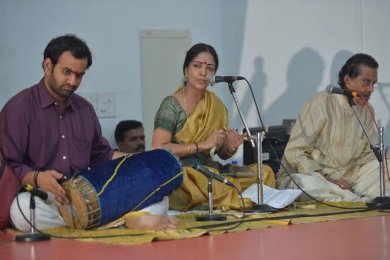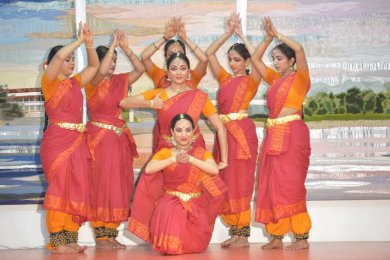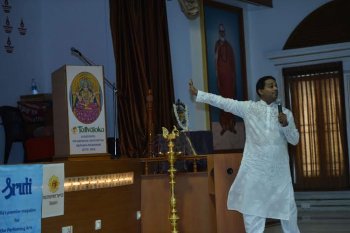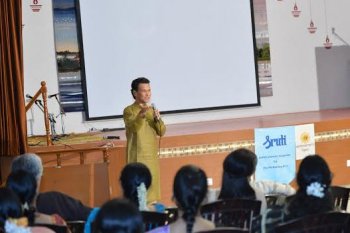
|   |

|   |
Nritya Samrachana: Inspiring perspectives on dance designs - Vaishnavi Ananthanarayanan e-mail: vaishsai@gmail.com Photos: Hariharan Sankaran January 11, 2014 Nritya Samrachana (16 - 18 Dec 2013), jointly organized by Apsaras Arts, Singapore and The Sruti Foundation brought together some of the most renowned names in the field of classical dance, particularly Bharatanatyam with an objective of sharing ideas on dance designs. The event was inaugurated by Bharatanatyam guru Prof. Sudharani Raghupathy. The first session by the evergreen couple, the Dhananjayans, on ‘Composing and Innovation in Margam’ was a fitting start to the sessions to follow. The Dhananjayans, known for their innovations and novel ideas, threw light on how minor diversions from the well set path of the margam could infuse some freshness into the dance presentation. They elaborated on the Nrityopaharams (Varnams) that they had choreographed, especially one specially meant for male dancers and one more patterned in the form of a conversation between two dancers with swarams and sahityams being woven alongside each other beautifully. They have also renamed a few known items to make it more apt to what is being presented. For example, they call the Jathiswaram as Nritta Swaravali. The next session took the audience back to the Natya Sampradaya, where Dr. Nandini Ramani explained the ‘Features of Sampradaya Varnam.’ She is a senior torch bearer of the ‘Bala’ tradition, having been trained by the legendary T Balasaraswati, and her close associate, nattuvanar K Ganesan. She explained how in the Kandappa bani, the music would be sung continuously while the jathi was being recited and performed. Precision of tala was so accurate that this was done seamlessly by the singer and nattuvanar. Even the tisram was not made very obvious, the mridangist would give an ‘arudhi’, which would be called ‘tisram amartikardu’ and then tisram phrases would be executed. The last swara of the charanam was known as the makuta swara, which would have several poi adavus (false adavus – where adavus are performed without stamping the foot hard on the ground). This swaram would have no sahityam as the swaram was considered the penultimate finale of the sampradaya varnam. Further, Nandini shared how sanchari was never rehearsed in advance and a particular concept would be gradually built up by the artiste who would need to be well versed about the story line and other allied information that had to be brought out in the sanchari. The last session for day 1 was by dance scholar and musician Sujatha Vijayaraghavan and playwright-director Dr. Gowri Ramnarayan on ‘Scripting for Dance’ with particular focus on solo performances. It was a real eye opener to know how important scripting was, not only for thematic and group presentations, but even for solo performances. Scripting gives scope for precise detailing which, apart from giving the dancer an idea on exactly how to proceed with the concept, gives all allied artistes a clear picture of the entire work as well as where they would need to play a role and how it should fit into the larger picture.  The Charis  Disciples of B Bhanumati Day 2 started off with a brisk session on ‘Rhythm Play in Choreography’ by Vasantalakshmi and Narasimhachari, who is not only a multifaceted dancer but a seasoned vocalist and mridangist, is well known for his intricate work with rhythm. Their presentation interspersed with relevant visuals, especially of their recent work Pallaki Seva Prabandhamu made it very interesting and inspiring, particularly for young artistes. This was followed by an enthralling lecture demonstration on ‘Facets of Group Choreography’ by B. Bhanumati and her students. Bhanumati’s famous dance feature ‘Bharatanjali’ has seen over 700 shows. Her presentation was very well laid out with plenty of demonstrations with her students for various group formations specifically for jathis, swarams as well as sahithyams. The striking feature of her session were that each of her students was so well trained and in perfect alignment with each other that it came out in their dance together which was seamless, precise and extremely aesthetic.  Dr. Padma Subrahmanyam The concluding session for day was by two veterans Dr. Padma Subrahmanyam and Prof. C. V. Chandrasekhar on ‘Composing Music for Dance.’ Padma dwelt on certain aspects of music that were in vogue especially in ancient theatre like the ‘Pravesha Dharu’ and ‘Utthara Pratyuktara Dharu.’ She went on to elucidate how music has to be absolutely coordinated with the dance movement and how the music helps the artiste to remember and perform the movement in the right flow. Her presentation was interspersed with relevant demonstration, especially the ‘sukhalasya’ from which one could perceive how the body moves to each swara. Prof. C.V. Chandrashekhar explained how the music should be in line with the dance and concept. CVC sir beautifully sang many of the pieces he had composed as his daughter and disciple Manjari Chandrasekhar did the demonstration, thus conveying clearly to the audience how music and dance need to be interwoven. He also included sounds and voice modulation to convey a concept. Swarakasharas, ragas appropriate to the mood, onomatopoeic sounds and a clear understanding of the concept were ideal facets of composing music for dance according to C.V. Chandrashekhar. The last day started off with a vibrant session by the trio Roja Kannan, Priya Murle and N. Srikanth. Each of them is a seasoned soloist and are disciples of different gurus, yet they have come together and worked in collaboration bringing out outstanding productions. Their topic on “challenges in collaboration” was dealt with beautifully by all 3 of them. The session was very well presented with the right mix of lecture, demonstration, video clips and open discussions. They explained how they work together, taking portions from each others’ styles yet retaining their individuality in their solo presentations. The three key things to be able to make collaboration successful according to the trio were: 1. Have no ego, 2. Have an internal leader and ensure good P.R., and 3. Cultivate healthy competition. The second session for day 3 was shared between Aravinth Kumarasamy from Apsaras Arts, Singapore and Ramli Ibrahim from Malaysia. Their topic on sets, light and dance design was a real eye opener to many young dancers in India, where such detailing is not common. Aravinth Kumarasamy explained how collaborating with the team of light designers, stage managers, sets designers, costume designers, etc was as important as working with the music composer, choreographers, musicians and dancers. The completeness of a visual presentation is perceived only if each of these departments understood the story, concept and theme completely. He showed excerpts from the recently staged ‘Angkor - An Untold Story,’ in which every person associated with the production was fully aware of the story line and concept and was therefore able to contribute aptly.  Aravinth Kumarasamy  Ramli Ibrahim Ramli Ibrahim has collaborated with several artistes across the globe. He gave his perspectives on working together, where all the members need to align in thought to be able to understand what each other needs and wants. Ramli mentioned about art directors branding their work to avoid copying. He also stressed that it is very important to find a creative director who could put everything together seamlessly and work with light technicians and stage personnel in different countries. The final session of Nritya Samrachana was a panel discussion on ‘Dance and the Media’ with Leela Venkataraman, Dr. Sunil Kothari, Alarmel Valli, Priyadarsini Govind, Veejay Sai, Vidya Saranyan on the panel and S. Janaki as moderator. The discussion was extremely interactive and threw forth many points from qualification of art critics to integrity and commitment of media. Those from the media felt that a review is a means of documentation and a platform to put forth the critic’s views in a constructive manner for the art and the artiste. Extremely interesting questions were raised by the audience and perspectives from both the performer’s side and media’s were put forth by the panel. The concluding session did leave several issues unanswered but gave a platform for many to voice their opinions. The three day lecture demonstration series sharing ideas on dance designs was indeed a well structured event. Although there have been several lec-dems on similar topics, there is always some take home when you listen to past masters and veterans in the field, who talk and present purely out of experience and knowledge gained through the years. |